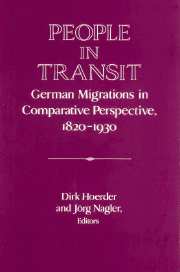Book contents
- Frontmatter
- Introduction
- PART I CONTINUITY AND COMPLEXITY: MIGRATIONS FROM EAST ELBIAN GERMANY AND GALICIAN POLAND
- 1 German Emigration Research, North, South, and East: Findings, Methods, and Open Questions
- 2 Colonist Traditions and Nineteenth-Century Emigration from East Elbian Prussia
- 3 Overseas Emigration from Mecklenburg-Strelitz: The Geographic and Social Contexts
- 4 Emigration from Regierungsbezirk Frankfurt/Oder, 1815-1893
- 5 Preserving or Transforming Role? Migrants and Polish Territories in the Era of Mass Migrations
- Part II Internal German Migrations and In-Migrations
- PART III WOMEN'S MIGRATION: LABOR AND MARRIAGE MARKETS
- PART IV ACCULTURATION IN AND RETURN FROM THE UNITED STATES
- 18 Migration Past and Present - The German Experience
- 19 Research on the German Migrations, 1820s to 1930s: A Report on the State of German Scholarship
- Index
1 - German Emigration Research, North, South, and East: Findings, Methods, and Open Questions
Published online by Cambridge University Press: 05 January 2013
- Frontmatter
- Introduction
- PART I CONTINUITY AND COMPLEXITY: MIGRATIONS FROM EAST ELBIAN GERMANY AND GALICIAN POLAND
- 1 German Emigration Research, North, South, and East: Findings, Methods, and Open Questions
- 2 Colonist Traditions and Nineteenth-Century Emigration from East Elbian Prussia
- 3 Overseas Emigration from Mecklenburg-Strelitz: The Geographic and Social Contexts
- 4 Emigration from Regierungsbezirk Frankfurt/Oder, 1815-1893
- 5 Preserving or Transforming Role? Migrants and Polish Territories in the Era of Mass Migrations
- Part II Internal German Migrations and In-Migrations
- PART III WOMEN'S MIGRATION: LABOR AND MARRIAGE MARKETS
- PART IV ACCULTURATION IN AND RETURN FROM THE UNITED STATES
- 18 Migration Past and Present - The German Experience
- 19 Research on the German Migrations, 1820s to 1930s: A Report on the State of German Scholarship
- Index
Summary
Germany, like Caesar's Gaul, est omnia divisa inpartes tres, as far as agricultural history is concerned. The areas of Gutsherrschaft east of the Elbe, dominated by great estates, contrast in important ways with the areas of Grundherrschaft in the west, with their more independent peasantry. These in turn are roughly divided between areas of impartible inheritance (Anerbenrecht) and of equal division among heirs (Realteilung) north and south of the Main, respectively. Obviously these are oversimplifications, but they help us to recognize commonalities in socioeconomic and particularly agrarian patterns that form the background for nineteenth-century emigration.
The heavy emigration from southwest Germany has usually been seen as a result of its custom of partible inheritance, which gradually led to splintering of holdings too small to be economically viable. Although this view is not entirely wrong, it is misleading unless further qualified. Partible inheritance was neither a necessary nor a sufficient condition for heavy emigration. Some areas of northwest Germany with systems of impartible inheritance had emigration rates rivaling those anywhere in the German Southwest. Moreover, areas with partible inheritance had emigration rates ranging from the highest to among the lowest throughout Germany.
Statistics gathered in 1895 for all counties (Kreise) in the German Empire show that among the areas with the highest proportion of “dwarf agriculture” (holdings under two hectares), three of the first five and six of the first twenty were indeed in Wurttemberg. But those in first and third place, Zellerfeld in the Harz and Siegen in southern Westphalia, both traditional centers of mining and metalworking, had rather low emigration rates. Moreover, among the six Wurttemberg counties, none was in the top quintile of net out-migration for the period 1813-67, and four were at or below the Wurttemberg average. And they showed similar trends for the period 1856-95. Five of the six lay within a thirty-kilometer radius of Stuttgart, and no doubt reflect the combination of part-time agriculture with industrial employment, a more modern version of the “handwerkende Bauern und verbauerte Handwerker” whom Wilhelm Heinrich Riehl observed back in the 1850s. These patterns reflect less the mechanistic operation of inheritance systems than the influence of specific local economic factors on both population density and migration patterns.
- Type
- Chapter
- Information
- People in TransitGerman Migrations in Comparative Perspective, 1820–1930, pp. 19 - 34Publisher: Cambridge University PressPrint publication year: 1995
- 1
- Cited by



